New beginnings for Cummins Turbo Technologies
21 June 2023
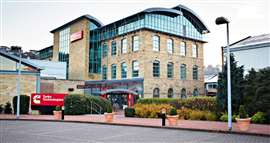 Tech Centre at Cummins Turbo Technologies in Huddersfield (All photos courtesy of Cummins)
Tech Centre at Cummins Turbo Technologies in Huddersfield (All photos courtesy of Cummins)
The Cummins Turbo Technologies plant in Huddersfield, West Yorkshire, plays a critical role in supporting the company’s global network of diesel engine production sites. Not only does the UK plant manufacture many of the medium- and heavy-duty turbos which feature on a variety of Cummins engines, but together with locations in India and China, the Huddersfield plant is also a development hub for new turbo technologies destined to support future power products.
Case in point is the new Cummins e-turbocharger for hydrogen fuel cell applications. Where a standard turbo will force more air into a combustion chamber to create a richer fuel/air mix and deliver more power, the e-turbocharger does essentially the same thing for fuel cells. Except that instead of supporting a bigger bang, the unit forces more air (read: oxygen) into the fuel cell stack to increase total electrical output.
Fuel cell e-turbocharger
At a recent press event held at the Huddersfield site, Simon Moore, Senior Engineering manager at Cummins, presented more information about how the e-turbo was developed and what applications will use the new technology.
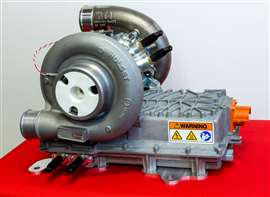 The first version of the Cummins e-turbo for fuel cell applications
The first version of the Cummins e-turbo for fuel cell applications
“We’ve elected to use an e-turbo over an e-compressor for three reasons, all related to efficiency: maximising peak stack power; duty cycle severity; and altitude performance,” said Moore. “The high-pressure e-turbo effectively increases power density, while recovering about 30% of what otherwise would be wasted energy.”
First previewed at IAA Transportation 2022 in Hanover, Germany, the e-turbocharger was developed by Cummins in collaboration with a series of partners, with additional funding from the Advanced Propulsion Centre under the APC 15 competition. This is the first of two versions which will be developed as part of the three-year project.
The unit comprises a compressor/impeller and a turbine on either side of an electric motor. Supplied by Aeristech, the direct-drive motor is specifically designed for high-speed applications. Speeds within the turbo can reach 112,000 rpm.
Unlike a standard turbo, which is powered exclusively by exhaust gas from the engine, only about 20 to 30% of the energy needed to power the compressor spindle comes directly from the fuel cell. Delivered via the turbine expander, this power is derived from the 85ᵒC water vapour exhaust generated by the fuel cell. The power shortfall is covered by the motor. Moore said that this harvesting of otherwise wasted energy has allowed the use of a smaller motor.
Goals for the second prototype include performance gains and size reductions, with what has been learned from this first example being used to develop a more powerful and compact unit.
This first e-turbo has been developed for use with a 250 kW fuel cell stack. This output would be suitable for use with the equivalent of a Class 8 HGV. According to Moore, Cummins was responsible for matching turbocharger performance to the fuel cell, including optimisation of compressor and turbine aerodynamics. Unlike most standard turbos, the e-turbo uses an air bearing system. This means there is no chance oil can escape and contaminate the fuel cell stack.
Plant makeover
In 2013, Cummins Turbo Technologies released plans for a multimillion-dollar programme of improvements. Over what would become known as Project Jupiter, there would be series of changes and upgrades made across the plant, updating both the infrastructure and internal layouts to gain performance and environmental efficiencies. After a cumulative five years of work, the Huddersfield site is now approaching the end of this journey and industry reporters were recently invited to the factory to see the changes.
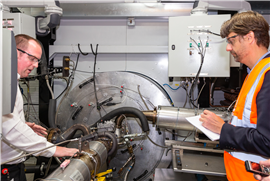 Cummins’ Matt Oakley (left) explains some of the key features of a new testing rig
Cummins’ Matt Oakley (left) explains some of the key features of a new testing rig
As with most manufacturing plants, operations are divided into separate yet interconnected buildings; while most are purpose-built, the Tech Centre entrance is located in a former textile mill [see opening photo]. There were once hundreds of such buildings in 19th century Huddersfield, but few original structures of this type now remain. It was decided to keep the building to help maintain the ‘living history’ element of the plant.
As part of the programme of improvements, the testing capability at Cummins has been extended to include a series of new test cells. Matt Oakley, technical operations leader, highlighted some of the changes put in place to support development of new turbo components.
“These two test cells are new, they were commissioned last year,” he says. “The compressor performance cell represents a $1.6 million investment. These new cells were designed and manufactured inhouse; they allow us to measure the performance of turbine and compressor technologies in a single cell. The cell can also talk to the PLC [programmable logic controller] to complete real time data analysis and diagnostics.”
He added that with older test cells, the technicians were sometimes “flying blind” when running tests, due to limitations with the technology. But the latest tech supports far deeper levels of performance analysis.
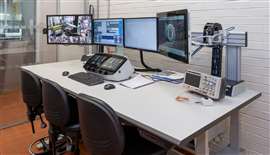 Test cell control bench
Test cell control bench
For the most part the cells are setup to deliver results based on fixed parameters, which ultimately allows the effect of changes to the turbo components to be measured on a level playing field in terms of overall performance efficiency. “In each section we have measurement points, pressure tappings and thermocouples, so we can tell exactly what is happening on all four gas connections of the turbo; compressor in and out, turbine in and out,” explained Oakley. A plenum chamber behind the rig serves as a temperature-controlled static air reservoir, again to support test standardisation and repeatability.
The technicians running the tests can view real time footage from cameras positioned within the cells, or they can toggle between the different data channels dependent on the type of testing.
Research and development
The Engineering Prototype division at Cummins Turbo Technologies has also benefitted from some considerable upgrades. Nick Hill, who is UK Prototype manager, offered some details about key changes.
“Speed and agility are very important to us. The engineers are designing new components daily; they could be produced here one day and the next they’ll be on test. The concept stage is ultimately what will deliver a competitive advantage in the market,” he said.
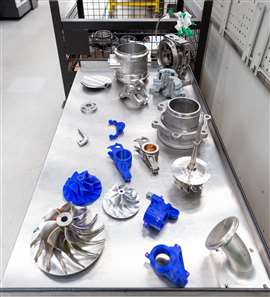 A selection of components produced by the Engineering Prototype division
A selection of components produced by the Engineering Prototype division
According to Hill, the prototype department delivers about 1400 individual parts and 200 full turbo units each month for testing. The division is almost 100% self-sufficient due to the onsite machine shop. “Our target is to remain agile for the business. We’re here purely to support what the business needs from us at any given time,” said Hill.
That means there’s no such thing as a fixed daily schedule – plans can change at a moment’s notice. The target turnaround time for a prototype part is 24 hours. Hill said it’s a challenge, but new machines and support technology have driven down part production times.
“Two years ago it would take about 12 hours to machine an impeller wheel from billet aluminium. With some development work, we got that down to six hours. Reprogramming of models and other software changes brought production down to about three hours and thirty minutes. With our new hardware we’re now down to about two hours for that same part and the goal now is to produce that part in an hour.”
Assembly halls
There have been some major changes to the Assembly division of Cummins Turbo Technologies. With regards to the buildings, very little other than the original steel frames remain in what is now a fully-refurbished manufacturing unit.
“There are four assembly lines across the plant and right now we’re producing between 4500 and 5000 turbos each week. If we were to implement a full three-shift rota over five days, we could achieve about 8000 units per week,” said Gary Waterhouse, plant manager.
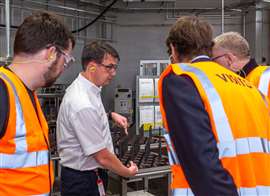 Gary Waterhouse (centre) explains how compressor wheels are welded to spindles in production
Gary Waterhouse (centre) explains how compressor wheels are welded to spindles in production
With regards to any new additions, Waterhouse said that there is some available space across the site, but most gains in terms of production area are made through changes in parts warehousing and other areas which can flex with regards to utilisation.
“We had what you could describe as an ‘aged’ site,” continued Gareth Cooper, Facilities leader. “There was no sprinkler system. Then there was no flood protection; the plant is in a flood zone. We had a lot of asbestos across the site and the last piece was removed about two months ago [April 2023]. Now all the buildings have new roofs which allow a lot of natural light. That will help cut related power consumption.”
To support ongoing manufacturing while completing the refitting process, Cooper said that each of the assembly line and machine tool units (about 300 assets in total) has been moved up to five times across the project, at a cost of around $3 million. But despite the works, manufacturing output was always a priority: “Not one customer has been disappointed during this process,” he added.
Ten years would seem a long time for such updates to be carried out, but this timeframe also included almost three years where no work was being done due to COVID (turbo production continued during the pandemic). But now, following the approximately $25 million refurbishment of the plant, the Cummins Turbo Technologies site in Huddersfield has been given nothing less than a new lease of life.
STAY CONNECTED




Receive the information you need when you need it through our world-leading magazines, newsletters and daily briefings.
POWER SOURCING GUIDE
The trusted reference and buyer’s guide for 83 years
The original “desktop search engine,” guiding nearly 10,000 users in more than 90 countries it is the primary reference for specifications and details on all the components that go into engine systems.
Visit Now
CONNECT WITH THE TEAM










